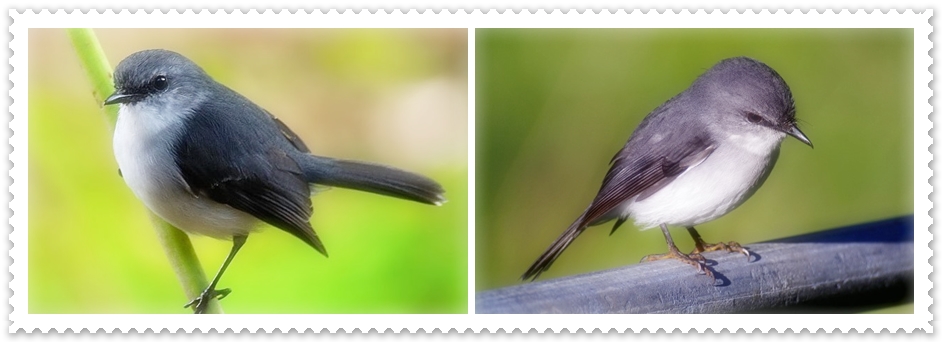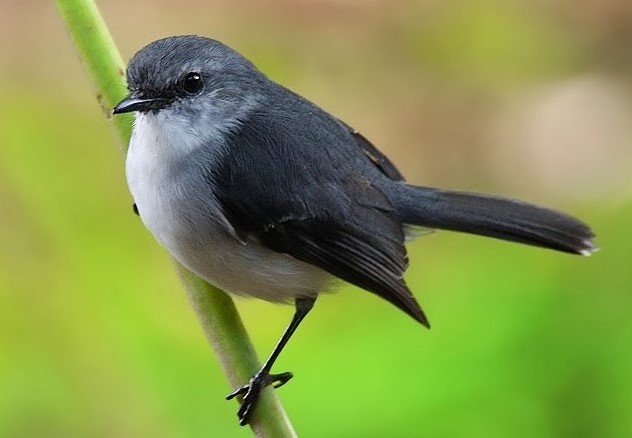Family and Genus: The white-breasted robin (Eopsaltria georgiana) belongs to the Australasian robin family Petroicidae as well as to the Yellow Robin genus Eopsaltria. Sometimes it is placed under the genus Quoyornis when it is referred to as such. In 1830, French naturalists Jean René Constant Quoy and Joseph Paul Gaimard described the white-breasted robin as Georgian Muscicapa. Unlike the European and American robins, the Australian robin is not closely related to either.
Habitats: The White-breasted Robin prefers dense thickets, whether they are near streams or in coastal heaths. The conventional theory suggests that this robin is an early evolutionary offshoot of the yellow robin that lost its yellow coloration after becoming isolated from eastern stocks during a past glacial period. Yellow Robins originated in the east but later spread west to breed off Eastern Yellow Robins.
Typically, the white-breasted Robin perches motionless, except for flicking its tail upwards—often at an angle of 45 degrees—and pressing the tips of its closed wings downward. Watching the ground for insects, it sometimes clings sideways, low on a tree trunk, as low as 100 mm. The sallies go out and down in swift dives, often to the ground, to capture them.

Behavior: Breeding birds perform distraction displays by running along the ground and trailing their wings. It is not uncommon for white-breasted robins to breed in groups with one to three helpers and occasionally as a pair. In successive years, the same nesting area is used. Neighbors do not attack one another, and only the nest environment is defended. Incubation of the eggs, brooding, and guarding of the young are all performed by the breeding female alone, never going further than 25 meters from her nest.
As well as seeking food, she is fed both on and off the nest by her mate and helpers. She also passes a portion of the food onto her nestlings. Both are in the nest, and when they leave, she and her mate feed the young directly. It is possible for a pair with a helper to raise three broods in a season, but it isn’t possible for a pair to raise three broods alone. There are more males than females, and helpers are usually descendants of the previous breeding pair. Helpers of their own sex are dominated by breeders. Females and juveniles remain in their nesting areas after the breeding season, while adult males disperse. Robins do not move and forage in groups when they are not breeding or away from their nests.
Diet: Foraging primarily on or near the ground, in or beneath undergrowth, the white-breasted robin is an insectivore. Beetles, wasps, ants, bugs, flies, and various insect larvae provide food for them.
Courtship: During courtship, the male feeds the female. A soft, warbling call erupts from her as she begs, quivering her wings. A loud, excited wee-oh or chirr-up is uttered by the male as he faces her, cocks his tail, fluffs out his body feathers, and bows to her. Males posture aggressively by holding their bodies upright, puffing out their feathers, and uttering harsh, churring calls.
Other Names: This beautiful robin is also known as a White-bellied Robin. The local indigenous people of Augusta call it “boydjil”.
Size: White-breasted Robins measure approximately 145–155 mm in length with a wingspan of 22–25 cm. In comparison, the female weighs 16.5 g, while the male weighs 20.5 g.
Identification: Both sexes are the same. The upper parts are plain dark smoky gray, lores are dusky black. Wings and tail are dusky, with a single white bar through the base of flight feathers that shows in flight; the bend of the wing is white; and the outer tail feathers are white-tipped. The underparts are white, while the breast and throat are washed gray. The eyes are dark brown. Black is the color of the bill. The feet are black-brown in color.
Immature: They resemble adults but may be spotted brown. The juveniles are brown, coarsely spotted, and mottled with white.
Call: White-breasted Robins make twick-twick, zick-ker-r-r when defending territory, and loud z-ick at dusk.
Song: The male bird chirrups are accompanied by animated chirrups. A liquid called che-op, ends abruptly like a whip crack in the morning and at night; sometimes it is e-che-op with e soft and drawn out like a dog whining.
Nesting and Breeding: Breeding and nesting occur between July and December-January. An upright fork of a small tree or shrub in dense scrub near water is usually decorated with lichen strips or bark strips attached to a loosely built cup of grass and rootlets.
Eggs: Usually, this adorable robin lays two eggs. They are light brown, olive, or pale green, with dim brown-red markings; oval, about 21 x 16 mm. An egg is incubated by a female for 14–15 days. It takes 12 to 14 days for the young to fledge.
Distribution: Currently, there are two populations in southwestern Australia. A moderately common population exists from north of Geraldton to Lancelin in dense coastal thickets. The southern population occurs between Busselton and Esperance, along streams and swamps, ranging in reduced numbers to Bald Island and Esperance. It occurs in the Darling Range to 250 m. There may be some nomadism or seasonal movement.
Races: Apparently, there are no races.
